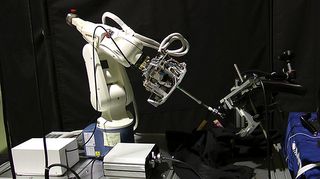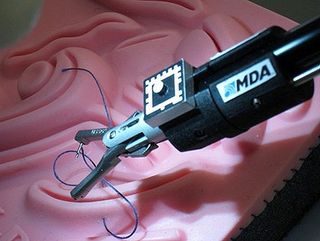Space Robot Arm Tech Could Help Surgeons Operate on Kids

The technology powering robotic arms in space could be used to perform minor surgeries for children on Earth.
MacDonald, Dettwiler and Associates (MDA) — the manufacturer of the robotic arms Canadarm and Canadarm2 — is now part of a project called KidsArm. The effort aims to use a mini-arm to automate some tasks during pediatric surgery.
Both space robotic arms were used to build the International Space Station. While Canadarm now only exists in space as a modified boom, Canadarm2 is still used today to capture the commercial Dragon and Cygnus cargo spacecraft visiting the station, and to assist astronauts during spacewalks, among other tasks. [The International Space Station in Pictures]
"Our tests indicate we can operate on tiny structures such as blood vessels without damaging them," said Thomas Looi, the program director for the Centre for Image-Guided Innovation and Therapeutic Intervention at the Hospital for Sick Kids (SickKids) in Toronto, said in a statement.
"The goal of the robotic arm is to help doctors perform certain procedures many times faster than if they were only using their hands, and with increased accuracy," Looi added. "Some of this would be done autonomously. While we are not quite there yet, KidsArm is able to perform three to five suture points autonomously."
KidsArm includes a vision-based system that works like robotic eyes, allowing guiding a small surgical arm to be guided to the spot it needs to reach in order to do its work. To figure out where to suture, KidsArm uses a stereo camera that creates a "3D point cloud" of spots to guide the tool tip into the zone.
KidsArm is in testing right now at SickKids to see if it will be useful for anastomosis, a procedure that involves connecting vessels and similar parts of the body. Researchers are testing the accuracy of the robotic arm's camera pointing system, and how well it puts in the sutures.
Get the Space.com Newsletter
Breaking space news, the latest updates on rocket launches, skywatching events and more!

SickKids announced the project in a NASA news release, but In a NASA press release, did not disclose when doctors plan to use the technology regularly for surgeries.
MDA is involved in several other surgical robotic arm projects. The company was a co-creator of the University of Calgary's neuroArm, which works inside an MRI and did its first operation in 2008. A new generation of arm is being developed for commercial use.
Additionally, MDA and Ontario's Centre for Surgical Invention and Innovation have a robotic arm, called Image-Guided Autonomous Robot, under clinical testing that could be useful for breast cancer diagnosis and surgery.
Follow Elizabeth Howell @howellspace. Follow us @Spacedotcom, Facebook and Google+. Original article on Space.com.
Join our Space Forums to keep talking space on the latest missions, night sky and more! And if you have a news tip, correction or comment, let us know at: community@space.com.

Elizabeth Howell (she/her), Ph.D., is a staff writer in the spaceflight channel since 2022 covering diversity, education and gaming as well. She was contributing writer for Space.com for 10 years before joining full-time. Elizabeth's reporting includes multiple exclusives with the White House and Office of the Vice-President of the United States, an exclusive conversation with aspiring space tourist (and NSYNC bassist) Lance Bass, speaking several times with the International Space Station, witnessing five human spaceflight launches on two continents, flying parabolic, working inside a spacesuit, and participating in a simulated Mars mission. Her latest book, "Why Am I Taller?", is co-written with astronaut Dave Williams. Elizabeth holds a Ph.D. and M.Sc. in Space Studies from the University of North Dakota, a Bachelor of Journalism from Canada's Carleton University and a Bachelor of History from Canada's Athabasca University. Elizabeth is also a post-secondary instructor in communications and science at several institutions since 2015; her experience includes developing and teaching an astronomy course at Canada's Algonquin College (with Indigenous content as well) to more than 1,000 students since 2020. Elizabeth first got interested in space after watching the movie Apollo 13 in 1996, and still wants to be an astronaut someday. Mastodon: https://qoto.org/@howellspace
